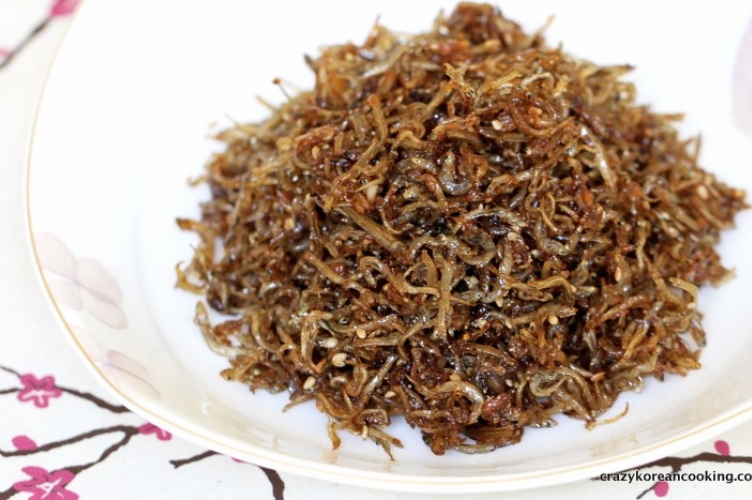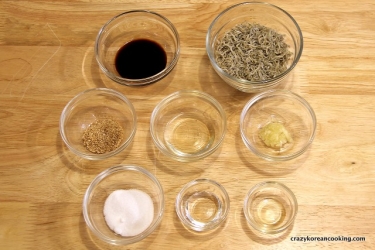Pan-fried Anchovies, Myeolchi Bokkeum
멸치볶음

Myeolchi Bokkeum ("Myeolchi" means anchovy, "Bokkeum" means pan-fried) is a traditional Mit-Banchan that is still widely loved today. "Mit" means bottom or foundation. "Banchan" is a side dish served with rice at every meal. So Mit-Banchan means fundamental side dishes served at every meal.
A typical Korean meal consists of a bowl of rice, a main dish, a soup or stew and a few different banchans. By having pre-made Mit-Banchan's in your fridge, you don't have to cook several side dishes for every meal. People often make a big batch of Mit-banchan and keep it in the fridge for weeks. Then it's served at daily meals along with other freshly made banchan's. Mit-banchan is usually saltier than other banchan's, so it's eaten a little bit at a time, with rice. The saltiness preserves the dish for a long time.
Myeolchi Bokkeum is salty but it has really nice sweetness to it, so even kids love it. It's a great way to enjoy anchovy which is high in calcium. It's also popular as a lunch box item because it can be served as it is right out of fridge.
This recipe features very fine anchovies called "Jan-Myeolchi" ("Jan" means tiny or fine, and "Myeolchi" means anchovy) which can be found in Korean markets. Sometimes green chili peppers or nuts are added. Medium-sized anchovies can be used as well but the seasoning is usually less sweet and gochujang or gochugaru is often added to create a spicy version.
Buy Korean ingredients online here.
Myeolchi Bokkeum ("Myeolchi" means anchovy, "Bokkeum" means pan-fried) is a traditional Mit-Banchan that is still widely loved today. "Mit" means bottom or foundation. "Banchan" is a side dish served with rice at every meal. So Mit-Banchan means fundamental side dishes served at every meal.
A typical Korean meal consists of a bowl of rice, a main dish, a soup or stew and a few different banchans. By having pre-made Mit-Banchan's in your fridge, you don't have to cook several side dishes for every meal. People often make a big batch of Mit-banchan and keep it in the fridge for weeks. Then it's served at daily meals along with other freshly made banchan's. Mit-banchan is usually saltier than other banchan's, so it's eaten a little bit at a time, with rice. The saltiness preserves the dish for a long time.
Myeolchi Bokkeum is salty but it has really nice sweetness to it, so even kids love it. It's a great way to enjoy anchovy which is high in calcium. It's also popular as a lunch box item because it can be served as it is right out of fridge.
This recipe features very fine anchovies called "Jan-Myeolchi" ("Jan" means tiny or fine, and "Myeolchi" means anchovy) which can be found in Korean markets. Sometimes green chili peppers or nuts are added. Medium-sized anchovies can be used as well but the seasoning is usually less sweet and gochujang or gochugaru is often added to create a spicy version.
Buy Korean ingredients online here.
INGREDIENTS
shop these ingredients online »| 2 oz | Anchovy, Small or Fine, Dried 잔멸치 | |
| 1½ tbs | Soy Sauce (regular) 왜간장 | |
| 1 tbs | Sugar 설탕 | |
| 2 tbs | Vegetable Oil 식용유 | |
| 1 tsp | Mul Yeot / Malt (Maltose) Syrup 물엿 (can use Jocheong (korean rice syrup) or honey) | |
| 1 tsp | Garlic (minced) 다진 마늘 | |
| 1 tsp | Sesame Seeds 깨 | |
| 1 tsp | Cheongju, Korean Rice Wine 청주 (optional) |

Optional Ingredients and Substitutions
Mul Yeot: You can use jo-cheong (Rice Syrup) or honey instead.
Cheongju, Korean Rice Wine: You can use sake, white wine or mirim instead.
Kkwarigochu and nuts:
You can add a few shishito peppers ("kkwarigochu" in Korean 꽈리고추) or nuts such as almonds or peanuts to make your dish more flavorful. If you are using kkwarigochu (shishito pepper), blanch them in boiling water with a pinch of salt until soft and drain. Pan-fry together with anchovies. Ground nuts are added at the end and cooked on low heat for another minute.
How to store
Seal tightly in a container and store in the fridge. If kept well, it can last at least 2 weeks. But, check the smell to see if it’s still ok to eat after a week or two.
To keep it safely for a long time, make sure you don’t touch the food with used spoons or chopsticks when transferring it from the container to the serving table. Also, it’s better to keep them in a few small containers so you don’t have to keep opening the container every time you eat. Every time you open the container you are increasing the chance of contamination.
You can also freeze it to keep it for months and thaw in fridge or in the microwave.
More questions? Please leave your questions below in the comments section. We will do our best to answer as soon as we can.
instructions |
photos |
summary |
|---|---|---|
Ingredient amounts in the recipe instructions are for the default serving size. |
Click to enlarge photos. |
Ingredient amounts in the recipe summary are for the default serving size. |
1. Wash (Optional)Put 50 grams of anchovies in a sieve or a fine strainer and rinse once under running water. Shake the sieve to drain water. |
1
Rinse in sieve
Drain water | |
2. Pan-fry Anchovies (Optional)Sauté anchovies in a pan on low heat while stirring until they are completely dried. This step is also optional but it helps reduce the fishy smell of anchovies. |
2
Pan-fry anchovies
| |
3. SautéAdd 2 tablespoons of vegetable oil to a non-stick pan and preheat for 1 minute on medium heat. Add 1 teaspoon of minced garlic and keep stirring. As soon as the garlic releases its aroma (do not let it turn brown) add anchovies, 1½ tablespoons of soy sauce and 1 teaspoon of rice wine. Pan-fry for 1 minute on low heat. If you like, you can add 5-7 blanched shishito peppers (Kkwarigochu 꽈리고추) or 1 tablespoon of ground nuts such as almonds or peanuts in this step. |
3
Preheat pan
Sauté
Add
| |
4. FinishTurn off the heat. Add 1 tablespoon of sugar, 1 teaspoon of malt syrup and 1 teaspoon of sesame seeds and mix them thoroughly. If you add sugar and malt syrup while heat is one, it will get hard. |
4
Turn off heat Add
Mix well | |
5. ServeServe on a side dish plate. Enjoy! |
5
Serve & Enjoy! |














 1 min
1 min